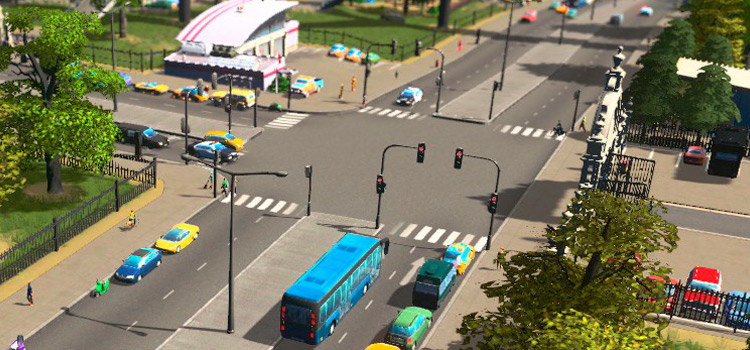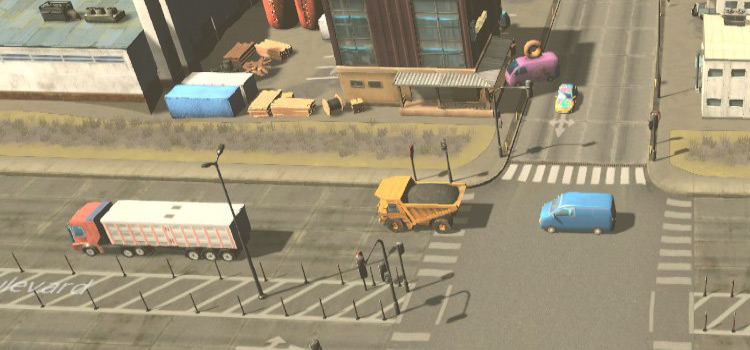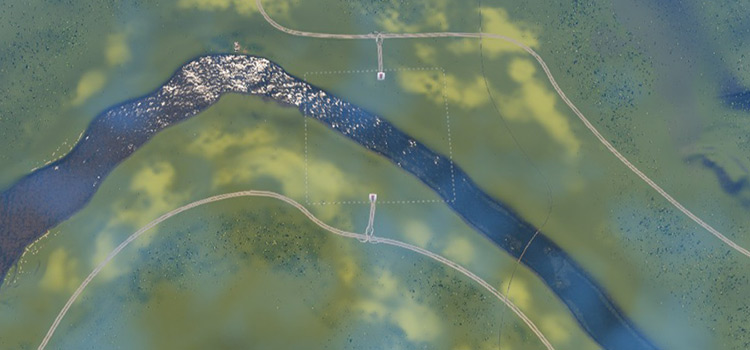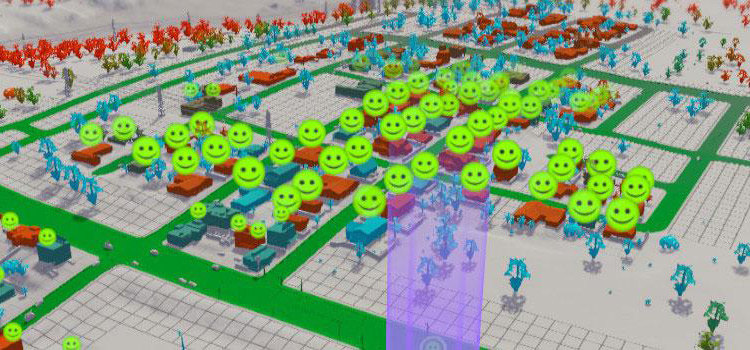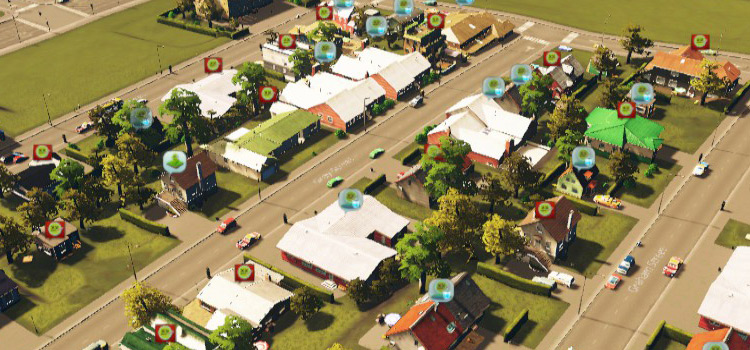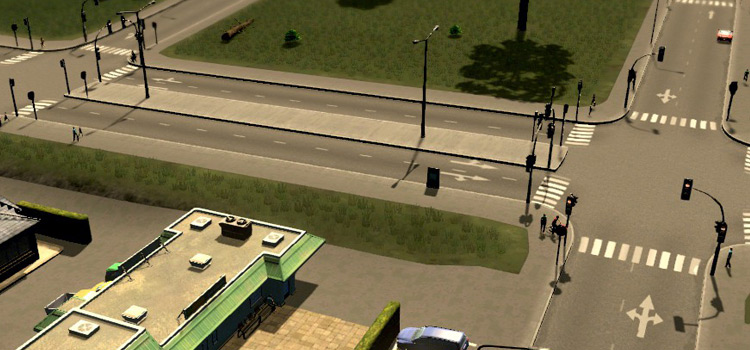
Here’s a simple list of the best ways to reduce noise pollution in your city. More details on these methods will be covered in this guide.
- Build specialized roads with noise barriers (best method)
- Plant trees and place parks in noise heavy areas
- Plan zoning to keep residential areas away from industrial/commercial zones
- Use public transport to cut down on traffic noise
- Use districts to set restrictions on traffic types and transportation methods
Method 1: Noise Reducing Roads (Most Effective)
There are many types of roads that can help control noise pollution.
The table below shows which types of roads reduce noise, listed from least effective to most effective.
| Road Type | Build Suggestions |
|---|---|
| Small Roads | Two-Lane Road with Grass -> Two-Lane Road with Trees |
| Medium Roads | Four-Lane Road with Decorative Grass -> Four-Lane Road with Decorative Trees Large Avenue with Grass |
| Large Roads | Six-Lane Road with Decorative Grass -> Six-Lane Road with Decorative Trees |
| Highways | One-Way Highway with Sound Barriers Two-Way Highway with Sound Barriers Highway with Sound Barriers Four-Lane Highway with Sound Barriers |
Method 2: Planting Trees
Planting trees is an easy way to reduce noise polluted areas.
Just like in real cities, trees will stop sound from traveling as far and allow you to control noise levels.
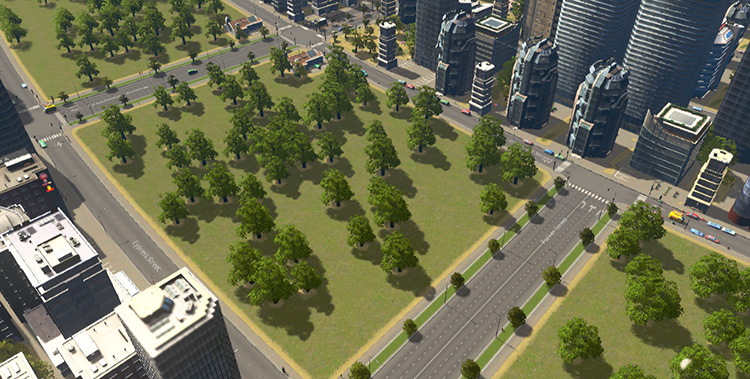
With a setup like in the picture above, the noisy commercial zones have no effect on the nearby residential zones because of the tree placement.
It’s a simple but effective way to control noise in your city.
Parks are also great ways to reduce noise just like trees, and they boost property value as well.
Tip: Trees can be placed anywhere there is noise. Place them by roads, noisy zones, or even industrial and public transport buildings.
Method 3: Plan Your Zoning Efficiently
Planning ahead of time where you want your zones to be is important to control noise pollution before it even exists.
Typically, you’ll want to place residential zones away from commercial and industrial zones.
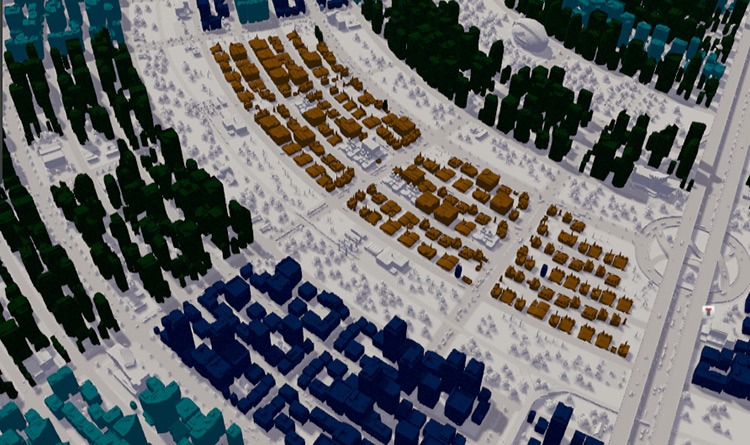
Pictured above is a simple zoning setup. The colors represent:
- Yellow – Industrial
- Blue – Commercial
- Teal – Office
- Green – Residential
Notice how each zone type has a different area. This helps reduce the noise crossover from different building types. Commercial zones can be closer to residential zones, but keep industrial zones far away from everything else.
Method 4: Districts and Policies
Drawing districts in different areas of your city can help you manage noise pollution in a specific area.
Districts allow you to set policies that control how your citizens get around, and what types of vehicles residents are allowed to travel with.
| Policy | What It Does |
|---|---|
| Free Public Transport (Services) | Encourage citizens to use public transport rather than drive their own car to cut down on traffic and noise pollution. |
| Heavy Traffic Ban (City Planning) | Ban heavy industrial vehicles from entering the district. These types of vehicles are the loudest, so removing them from residential areas reduces noise pollution. |
| Encourage Biking (City Planning) | Encourage your citizens to use a bicycle instead of a loud vehicle. This helps lower traffic and noise pollution. |
| NIMBY (City Planning) | This policy states that there is no loud noises at night. Leisure districts will shut down at night and have reduced noise pollution. |
| Old Town (City Planning) | Ban all traffic except for residents and business owners in the district. This helps cut down on traffic and noise pollution coming from outside the area. |
Method 5: Public Transport
Using public transport is a great way to reduce noise pollution in your city. There are various types of public transit that you can use in your city which all reduce the number of vehicles on the roads, reducing noise pollution.
Subway stations, bus terminals, and taxi cabs are excellent ways to reduce noise pollution in an urban environment. Keep in mind that the buildings themselves do cause noise pollution, so place them strategically in your city.
Even with the small amount of noise pollution that the public transit buildings provide, it will be worth it once your lines are up and running.
Cargo train terminals, cargo airports, and cargo harbors are fantastic ways to reduce industrial traffic going through your city. Instead of industrial vehicles using the main roads of your city, place these buildings near industrial areas so heavy traffic goes there for exporting goods instead of all around your city.
What Should You Do First?
By far, the easiest and most effective way to control noise in your city is by building roads suitable for noise reduction.
Planning your city layout ahead of time is also essential to building an efficient city, so try to plan your roads as your city expands. However, don’t neglect the other methods we mentioned above – because they can all work with each other to help you make the best city possible.
Tip: You can use the upgrade tool on roads to seamlessly upgrade existing roads into better noise-control roads.
-
Cities: Skylines
- How To Reduce Noise Pollution in Cities: Skylines


